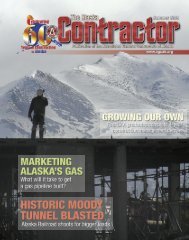The Alaska Contractor: Special 60th Anniversary Issue
The Alaska Contractor: Special 60th Anniversary Issue
The Alaska Contractor: Special 60th Anniversary Issue
Create successful ePaper yourself
Turn your PDF publications into a flip-book with our unique Google optimized e-Paper software.
PH O TO: LA R RY MO O R E & ASSOCIATES<br />
By Ron Dalby<br />
Remembering when he got off the boat in Ketchikan in 1952, Darrell Mc-<br />
Birney said, “I worked for whoever would have me.” He would later move to<br />
Fairbanks in 1958.<br />
For McBirney, coming to <strong>Alaska</strong> “just seemed like the<br />
thing to do. <strong>The</strong> market dried up at the little business I<br />
had [in Las Vegas] like in December [1951], and I went to<br />
work on Frenchman Flats for about four or fi ve months<br />
before I came up here. That’s on that atomic energy<br />
proving ground.”<br />
Always willing to work, McBirney started with a<br />
contractor in Ketchikan who was building an addition<br />
on the White Cliff School. “I lost my hand on<br />
that project and I was laid up for about nine months<br />
or a year. I went back Outside for three or four operations<br />
… more like seven or eight operations, and<br />
then came back up the following spring. I’ve been in<br />
<strong>Alaska</strong> ever since.”<br />
His company, CJM Construction, has “done a little<br />
bit of everything. <strong>The</strong> only home building I’ve done in<br />
<strong>Alaska</strong> has been either for the Corps of Engineers or the<br />
Air Force—never building for resale or that nature.<br />
“I’ve been in the commercial and industrial end of it<br />
since then, primarily buildings.”<br />
<strong>The</strong> list of jobs McBirney’s been involved with over<br />
the years reads like a list of <strong>Alaska</strong>’s major building<br />
projects, particularly in the Interior. When queried, his<br />
eyes twinkle yet again, and he starts reciting, “Lathrop<br />
High School, the Fine Arts Complex at the University of<br />
<strong>Alaska</strong> [Fairbanks], the Woodshed at the University of<br />
<strong>Alaska</strong>, the biosciences building and the airport terminal<br />
expansion [Fairbanks]. How many more do you want?”<br />
he asks, laughing.<br />
When asked about various government projects, he<br />
laughs again and says, “You don’t want to hear them<br />
[stories about working for the government]; too many<br />
four-letter words.”<br />
As far as government regulations go, “Actually I doubt<br />
that it’s any worse here than it is anywhere else. You get<br />
into things which are absolutely haywire.”<br />
Telling stories<br />
Spend a few minutes with McBirney and you quickly<br />
realize that his reminiscences are fi lled with lively stories<br />
Darrell McBirney<br />
‘I think there’s bigger<br />
things coming’<br />
from bygone eras, like a job he once had in Valdez.<br />
“Hewitt [Construction] had done the fi rst phase of<br />
it, which was the earthwork,” he said. “<strong>The</strong> architect had<br />
designed the building to sit on top of that earthwork, but<br />
they didn’t set it on top of the earthwork. <strong>The</strong>y set it off<br />
to the side.<br />
“<strong>The</strong>y didn’t go back to check to make sure of what<br />
they were doing and consequently from there on through<br />
the project nothing fi t.<br />
“We sat down and made a list of everything that<br />
was haywire and I had a fellow working with me in<br />
Anchorage where the architect was. I asked him to go<br />
in and take the list to the architect of the most pressing<br />
and on down the line so that we could keep the<br />
work moving.<br />
“I got a letter from the architect telling me they didn’t<br />
want him disrupting them anymore because he was too<br />
disruptive in their offi ce.” In the meantime, McBirney<br />
was still trying to get on with the building. Eventually<br />
it got fi nished, but not without a lot of on-the-spot<br />
adjustments.<br />
A bit of history<br />
“I really liked the airport project best of any that we’ve<br />
done because of the outcome at the end,” McBirney said.<br />
“Towards the end was the visit of President [Ronald]<br />
Reagan and Pope John Paul meeting at the airport. <strong>The</strong><br />
airport wasn’t completed, but we cleaned the airport up<br />
and fi nished off a room for them to meet.<br />
“Regardless of what your political affi liation is or<br />
your religion, the fact that Pope John Paul and President<br />
Reagan met here in Fairbanks was quite a feat.”<br />
Challenges<br />
“Challenges come in different forms,” McBirney said.<br />
“Some in the construction itself and some in the people<br />
you are working for.<br />
“I can’t think of one right now that was more challenging<br />
than the other. Of course you always had the<br />
challenge … you were trying to get your building enclosed<br />
before the cold weather so that you could work<br />
40 <strong>The</strong> <strong>Alaska</strong> conTrAcTor <strong>60th</strong> <strong>Anniversary</strong> <strong>Issue</strong> 1948–2008

















